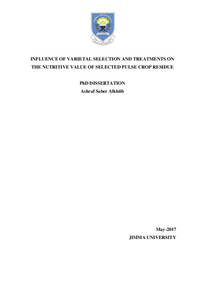Influence of Varietal Selection and Treatments on the Nutritive Value of Selected Pulse Crop Residue

Authors:
The current study was aimed to analyze the utilization of crop residue in the mixed farming
systems of Ethiopia, to explore the possibility of improving straw yield and nutritive value of
chickpea, faba bean and lentil without compromising grain yield and to identify the effect of
dung and wood ash treatments on the nutritive value of chickpea, faba bean and lentil straw.
Data on crop residue production and utilization was collected in two highland regions of
Ethiopia from 160 households. To assay the varietal variation and food-feed relation in faba
bean, 4 improved and released variety and one local variety were planted at the Sinana
Agricultural Research Center, Ethiopia during 2014-2015 cropping season. To evaluate the
variability in grain yield and straw traits in chickpea and lentil, 24 improved varieties and one
local variety of each crop were replicated four times in a randomized complete block trial in
two locations of Debre Zeit Research Center during the 2013-2014 cropping season. Straw
from plots of the local varieties of the trials was used to determine the effect of 4% urea
treatment, dung ash treatment (0g ash/L, 100 g ash/L, 200 g ash/L 300 g ash/L) and wood ash
treatment (0 g ash/L, 150 g ash/L, 200 g ash/L) on the nutritional value. All straw samples
were analyzed for proximate analysis, in vitro organic matter digestibility and metabolizable
energy using a combination of Near Infrared Reflectance Spectroscopy and conventional feed
analyses methods.
Results showed that farmers prefer using crop residue from pulses over crop residue from
cereals for livestock feeding purposes. Proportions of cereal and pulse residue used for soil
mulch was positively affected by education level of the farmer, distance between homestead
and cultivated land, extension service, awareness about soil mulch, slope of cultivated land,
participation in farmer-to-farmer extension and crop residue generated in the preceding
season. The proportion of crop residue from pulses that was used as feed was positively
affected by education level of the farmer, livestock extension service, number of small
ruminants and crop residue stack from the previous season. The effect of the variety, location
and variety-location interaction on grain yield, straw yield and straw nutritive value was
1
significant in chickpea and lentil. The correlation between grain yield and straw traits of
chickpea was weak in all locations. Grain yield of lentil correlated weakly to crude protein
and ME in Chefe Donsa while it correlated moderately to crude protein in Zebre Zeit. Grain
and straw yields were positively, strongly and significantly correlated in faba bean. Grain
yield of faba bean correlated weakly to the nutritive value parameters of straw. Varietal
variations in grain yield, straw yield and straw quality traits within its fractions were
significant. The botanical structure of faba bean straw can be used as a reliable method for
screening faba bean genotypes for straw quality. Urea treatment showed potential to improve
the nutritive value of chickpea, faba bean and lentil straw. Dung ash treatment up to 300 g
ash/L and wood ash treatment up to 200 g ash/L did not improve the nutritive value of
chickpea, faba bean and lentil straw.
Integrating straw yield and nutritive value into improvement programs of chickpea, faba bean
and lentil could improve the nutrients supply for livestock and increase the amount of cereal
straws allocated to soil mulching.
